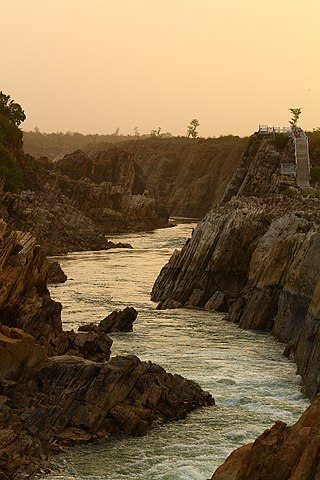
The Narmada River, previously also known as Narbada or anglicised as Nerbudda, is the 5th longest river in India and overall the longest west-flowing river in the country. It is also the largest flowing river in the state of Madhya Pradesh. This river flows through the states of Madhya Pradesh and Gujarat in India. It is also known as the "Lifeline of Madhya Pradesh and Gujarat" due to its huge contribution to the two states in many ways. The Narmada River rises from the Amarkantak Plateau in Anuppur district in Madhya Pradesh. It forms the traditional boundary between North and South India and flows westwards for 1,312 km (815.2 mi) before draining through the Gulf of Khambhat into the Arabian Sea, 30 km (18.6 mi) west of Bharuch city of Gujarat.
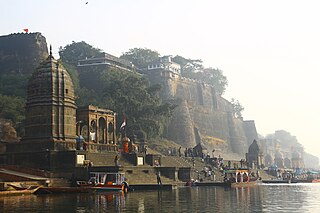
Maheshwar is a town, near Khargone city in Khargone district of Madhya Pradesh state, in central India. It is located on State Highway-38 ,13.5 km east of National Highway 3 and 91 km from Indore, the commercial capital of the state. The Town lies on the north bank of the Narmada River. It was the kingdom of Chaktavartin Samrat Sahastraarjun, Kartavirya Arjuna a Heheya king. Lately, after many years, it was the capital of the Malwa during the Maratha Holkar reign till 6 January 1818, when the capital was shifted to Indore by Malhar Rao Holkar III.

Pushkaram is an Indian festival dedicated to worshiping of rivers. It is also known as Pushkaralu, Pushkara or Pushkar.

Omkareshwar is a Hindu temple dedicated to Shiva, located in Mandhata, nearby Khandwa city in Khandwa district of the Indian state of Madhya Pradesh. It is one of the 12 revered Jyotirlinga shrines of Shiva. It is on an island called Mandhata, near Khandwa city in the Narmada river at Khandwa district in Madhya Pradesh, India; the shape of the island is said to be like the Devanagari ॐ symbol.
Mandleshwar is a town and nagar panchayat in the Khargone district of the India state of Madhya Pradesh. It is on the banks of Narmada River, 8 kilometres (5.0 mi) east of Maheshwar and 99 kilometres (62 mi) south of Indore. It is a "Pavitra nagri" as termed by the government of Madhya Pradesh, as it is an ancient town. It is the education centre of Maheshwar block, the location of the district court and district jail of Khargone, and is also the political centre of Maheshwar block.

Parikrama or Pradakshina is clockwise circumambulation of sacred entities, and the path along which this is performed, as practiced in the Indic religions – Hinduism, Buddhism, Sikhism and Jainism. In Buddhism, it refers only to the path along which this is performed. Typically, in Indic-religions the parikrama is done after completion of traditional worship and after paying homage to the deity. Parikrama must be done with dhyāna.
Barwaha is a municipality and sub district in Khargone district in the state of Madhya Pradesh, India situated on the banks of Narmada river. Barwaha is second biggest city of District after Khargone city. The Barwaha city is divided into 28 wards for which elections are held every 5 years. The Barwaha Municipality has population of 61,973 of which 32,940 are males while 29,033 are females as per report released by Census India 2011. Literacy rate of Barwaha is 87.27% higher than state average of 69.32%. In Barwaha, Male literacy is around 92.73% while female literacy rate is 81.23%.
Kayavarohan or Karvan is a village in the Vadodara district of the state of Gujarat, India. Kayavarohan is popularly known as Karvan and is situated on the National Highway 8 at a distance of 30 km from Vadodara. Kayavarohan is considered as the birthplace of Lakulisha, the second century C.E. Shaivite revivalist, reformer and propounder of the pashupata doctrine. It is an important religious place on account of its Lakulisha temple.
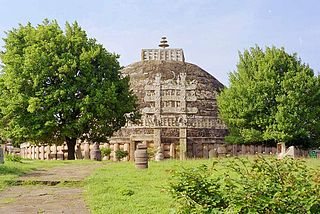
Tourism in Madhya Pradesh has been an attraction of India because of its location in the centre of the country. Madhya Pradesh has won Best Tourism State National award for 3 consecutive years i.e. 2017, 2016 and 2015.

Yatra, in Indian-origin religions, Hinduism, Buddhism, Jainism and Sikhism, generally means a pilgrimage to holy places such as confluences of sacred rivers, sacred mountains, places associated with Hindu epics such as the Mahabharata and Ramayana, and other sacred pilgrimage sites. Visiting a sacred place is believed by the pilgrim to purify the self and bring one closer to the divine. The journey itself is as important as the destination, and the hardships of travel serve as an act of devotion in themselves.

Banalinga, a stone found in nature, in the bed of the Narmada river in Madhya Pradesh state, India, is an iconic symbol of worship, based on either the scriptures or cultural traditions among the Hindus, particularly of the Shaivas and Smarta Brahmins. It is a smooth ellipsoid stone that represents a lingam, an anionic form of the deity Shiva.
Tadpakal is a village in Yergatla Mandal, Nizamabad district of Telangana in southern India. It sits by the Godavari River. Tadpakal or Tadapakala name is derived from TallaPaaka, during the 1900 to 1940 there were more Palmhuts in this village
Mardana is a village in the state of Madhya Pradesh located on the banks of the river Narmada in India. The village falls under the Nimar region. The region predominantly speaks the local dialect "Nimadi" and Hindi. Nearest airport is Indore and nearest railway station is Khandwa.
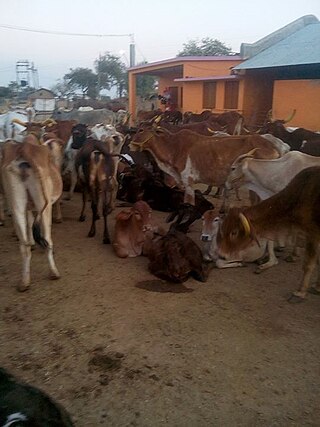
Bakawan is a village in the state of Madhya Pradesh located on the banks of the river Narmada in India. The village falls under the Nimar region in Malwa. The region predominantly speaks the local dialect "Nimadi" and Hindi. Nearest airport is Indore and nearest railway station is Khandwa.

Godavari Maha Pushkaram was a Hindu festival held from 14 July to 25 July 2015. This festival occurs once every 144 years, corresponding to the 12th recurrence of the 12-year Godavari Pushkaram cycle.

Krishna Pushkaram is a holy festival in Hinduism to worship the Krishna River, which is one of the 12 sacred rivers in India. The holy festival is observed in the banks along it, usually held in the form of fairs, praying halls, or Hindu temples with ghats along the river. The festivity normally occurs once in every 12 years and is celebrated with much glory due to its occurrence once every 12 years, and the holiness of the event. The duodecennial festival has over 50 million attendees during the 12 days, and many workplaces offer a break during the festival in regard of its importance.

Yamuna Pushkaram is a festival of River Yamuna normally occurs once in 12 years. This Pushkaram is observed for a period of 12 days from the time of entry of Jupiter into Karka rasi (Cancer).
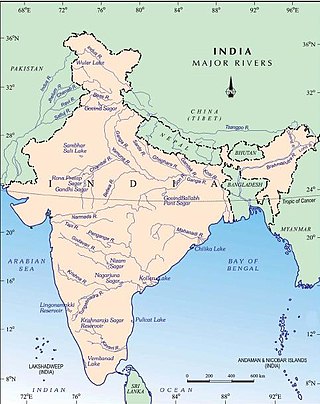
The Bhima Pushkaram is the Pushkaram river festival organized on the banks of the Bhima river. It is a Hindu festival, organized once every 12 years. Thousands of people dive in to take a bath as worship. The Rashi or the Hindu zodiac sign for this river is Vrishchika or Scorpio.
The Yogananda Lakshmi Narasimha Swamy Temple, also known as Mattapalli Narasimha Temple, is a Hindu temple dedicated to Narasimha, the half-man half-lion avatar of Vishnu, and his consort Lakshmi. It is located in Mattampally, a village in the Mattampally mandal of Suryapet district in the Indian state of Telangana. One of the Pancha Narasimha Kshetras, the temple is located on the banks of the Krishna River, and was built in the 11th century by Anumala Machi Reddy, the king of Thangedu region after the deity appeared in his dream and instructed him to do so. The main shrine houses a swayambhu (self-manifested) idol of Narasimha as Yogananda Lakshmi Narasimha, and was worshipped by sage Bharadvaja and other seers for hundreds of years before the temple was constructed. Lakshmi is worshipped here as Rajalakshmi Thayar and Chenchu Lakshmi Thayar.













